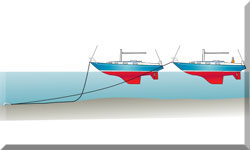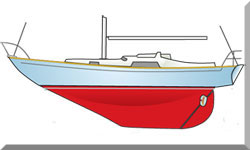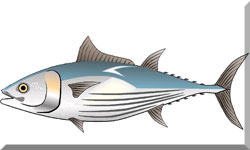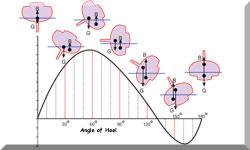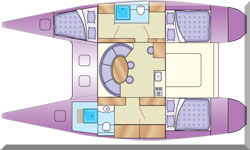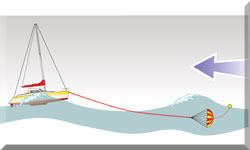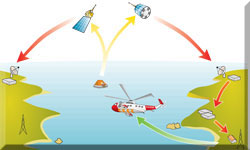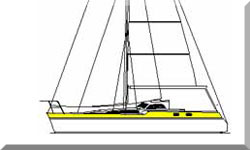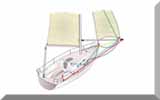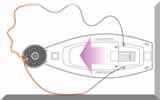- Home
- Offshore Sailing
- Sailboat Flag Etiquette
Sailboat Flag Etiquette: What You Need to Know
Sailboat flag etiquette is steeped in maritime tradition and enshrined in law. If you're new to the world of sailing, you may have wondered about the various flags that you see flying on other sailboats or that you are expected to fly on your own. What do they mean? How should they be displayed? What are the rules and traditions that govern them?
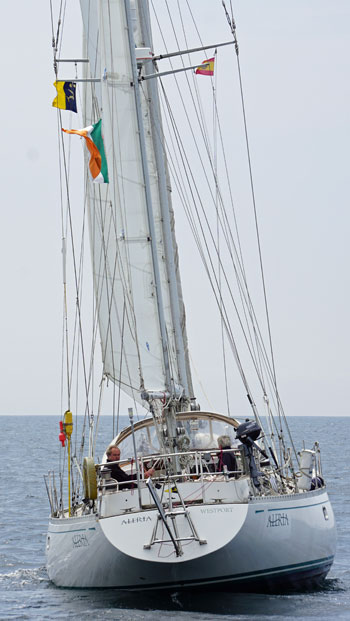 All good here...
All good here...An experienced sailboat skipper will know that flag etiquette is a way of showing respect, courtesy and recognition to other vessels, countries and organizations.
It also helps you communicate important information, such as your nationality, your club affiliation, your intentions or your distress.
For the less experienced we'll explain the basics of sailboat flag etiquette and how it should be applied in practice:
- The types of flags that you can fly on your boat;
- The sizes and positions of the flags;
- The occasions and situations when you should fly certain flags;
- The common mistakes and pitfalls to avoid when flying flags.
The skipper of the Bowman 57 staysail ketch shown here is correctly flying a burgee (the Flying Fish burgee of the Ocean Cruising Club) from the port spreader, and a courtesy ensign (of Spain in this case) from the starboard spreader.
The ensign, in this case that of the Republic of Ireland, is flown from a flag halyard from the mizzen mast to the end of the mizzon boom. Alternatively the ensign could be flown from a staff attached to the taffrail.
The Types of Flags
There are many types of flags that you can fly on your boat, but the most common ones are:
- The ensign: This is the flag that shows the country of registry of your boat and indicates its nationality. It is usually flown at the stern of the boat, as close as possible to the waterline. It is the most senior position for a flag on a boat and it should always be larger than any other flag. A UK flagged boat (sail or power) must wear the national maritime flag, the Red Ensign, unless entitled to wear a special ensign.
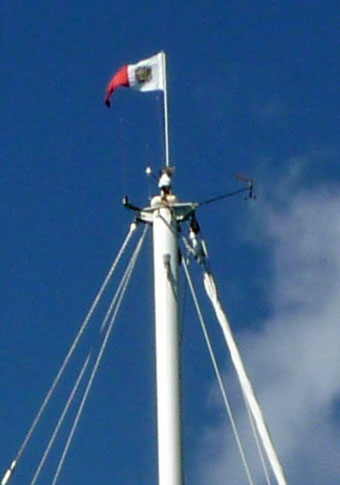 Club burgee correctly flown at the masthead
Club burgee correctly flown at the masthead- The burgee: This is the flag that shows the yacht club or association that you belong to. It is usually flown at the main masthead of the boat above any other flag, but can be flown from the port spreader unless otherwise stipulated under a special warrant.
- The courtesy flag: This is the flag that shows the national flag of the country that you are visiting or whose waters you are sailing in. It is a sign of respect and goodwill to the host country and it should be flown at the starboard spreader. It should be hoisted as soon as you enter foreign waters and lowered as soon as you leave them.
- The Q flag: This is a yellow flag that indicates that you are requesting clearance from the local authorities when entering a foreign port. It is also flown at the starboard spreader of the boat, below the courtesy flag if there is one. It should be hoisted before you enter the port and lowered after you have been cleared.
- The signal flags: These are flags that have specific meanings in the International Code of Signals. They can be used to spell out messages or to convey information such as your position, your course, your speed, your intentions or your distress. They can be flown individually or in combinations at various locations on the boat.
- The private signal: This is a personal or family flag that has no official meaning or recognition. It can be flown at the port spreader of the boat, below any other flag. It is optional and purely decorative.
The Sizes and Positions of the Flags
The sizes and positions of the flags on your boat are important for both aesthetic and practical reasons. They should be proportionate to your boat size, visible from a distance and clear from any obstruction.
The general rules for sizing and positioning flags are:
- The ensign should be one inch on the fly (the length) for every foot of overall length of your boat. It should be flown on the stern staff or on a gaff if there is one.
 The ensign flown at the mizzen masthead? Definitely not in accordance with the regulations!
The ensign flown at the mizzen masthead? Definitely not in accordance with the regulations!- The burgee should be half an inch on the fly for every foot of overall length of your sailboat or five-eighths of an inch for every foot of overall length of your powerboat. It should be flown at the main masthead or on a pigstick (a vertical extension) if there is one.
- The courtesy flag should be the same size as the burgee or slightly smaller. It should be flown at the starboard spreader, preferably on its own halyard.
- The Q flag should be the same size as the courtesy flag or slightly smaller. It should be flown at the starboard spreader, below the courtesy flag if there is one, on its own halyard.
- The signal flags should be sized according to their function and meaning. They can be flown individually or in combinations at various locations on the boat, such as the masthead, the yardarm, the bow or the stern of the boat.
- The private signal should be the same size as the burgee or slightly smaller. It should be flown at the port spreader, below any other flag, on its own halyard.
The Occasions and Situations When You Should Fly Certain Flags
The occasions and situations when you should fly certain flags on your boat depend on where you are, what you are doing and who you are with. Some flags are mandatory, some are optional and some are forbidden.
The general rules for flying flags are:
- You must fly your ensign at all times in daylight, especially when near to or in sight of land or another boat. You must also fly your ensign when entering or leaving a foreign port and on demand. You can fly your ensign at night if you wish, but it is not required.
- You can fly your burgee at any time, but it is customary to hoist it at 0800 and lower it at sunset. You can also fly your burgee at night if you wish, but it is not required.
- You must fly the courtesy flag of the country that you are visiting or whose waters you are sailing in as soon as you enter their jurisdiction and until you leave it. You must also fly the Q flag when entering a foreign port until you have been cleared by the local authorities. You can lower the Q flag after you have been cleared, but you should keep the courtesy flag until you leave the port or the country.
- You can fly signal flags whenever you need to communicate with other boats or shore stations using the International Code of Signals. You can also fly signal flags for decorative purposes, such as dressing your boat for a special occasion, but you should avoid using flags that have specific meanings or that could cause confusion.
- You can fly your private signal whenever you want, but it has no official significance or recognition. It is purely a personal or family emblem.
The Common Mistakes and Pitfalls to Avoid When Flying Flags
Flying flags on your boat can be fun and rewarding, but it can also be tricky and challenging. There are some common mistakes and pitfalls that you should avoid when flying flags, such as:
- Flying an incorrect, damaged, wrongly sized or otherwise invalid ensign. This is a breach of law and etiquette and could lead to fines or penalties.
- Flying a special ensign without being entitled to do so. This is a privilege granted by a warrant from the Admiralty or by an Act of Parliament and it requires certain conditions to be met.
- Flying a burgee that does not match your ensign or that is higher than your ensign. This is a sign of disrespect and ignorance and could offend other boats or authorities.
- Flying more than one burgee at a time. This is considered sloppy and excessive and could imply that you are showing off or indecisive.
- Flying a courtesy flag that is larger than your burgee or that is above your burgee on the same halyard. This is a sign of subservience and inferiority and could insult your own country or club.
- Flying a Q flag when you have already been cleared or when you are leaving a port. This is unnecessary and confusing and could cause delays or misunderstandings.
- Flying signal flags that have specific meanings or that could cause confusion for decorative purposes. This is irresponsible and dangerous and could lead to accidents or incidents.
- Flying a private signal that resembles an official flag or that has an offensive meaning. This is misleading and rude and could provoke anger or hostility.
- And you should never, ever, fly a skull-and-crossbones flag. There is nothing amusing or glamorous about pirates.
Sailboat Flag Etiquette: A Few FAQs...
Why do some British sailboats fly a White or Blue Ensign rather than the traditional Red Ensign?
Why do some British sailboats fly a White or Blue Ensign rather than the traditional Red Ensign?
Some British sailboats fly a white or blue ensign because they belong to certain yacht clubs or organisations that have special permission to use these ensigns.
The white ensign is a variation of the national flag that is normally used by the Royal Navy, but it can also be worn by yachts owned by members of the Royal Yacht Squadron, which is a privileged yacht club with a long history and close ties to the monarchy.
The blue ensign is another variation of the national flag that is normally used by government vessels, but it can also be worn by yachts that belong to one of the 32 yacht clubs or associations that have a warrant from the Admiralty or the relevant authority to use the undefaced blue ensign.
Additionally, some yachts can wear a blue ensign defaced with the badge of their club or association, if they have a warrant for that as well. There are 57 yacht clubs or associations that have this privilege.
These special or privileged ensigns are considered a mark of distinction and honour, and they should only be flown with proper authorisation and following the rules and regulations of wearing them.
What is the difference between an ensign and a burgee?
What is the difference between an ensign and a burgee?
An ensign is a flag that shows the nationality of the vessel and must be worn at the stern or as close to it as possible. A burgee is a flag that shows the membership of a yacht club or sailing association and can be worn at the masthead or the port spreader.
What is a special ensign and how can I get one?
What is a special ensign and how can I get one?
A special ensign is a variation of the national flag that can be worn by certain yachts that belong to a privileged yacht club or organisation. To get one, you need to apply for a warrant from the Admiralty or the relevant authority and follow the rules and regulations of wearing it.
How big should my flags be and how should I hoist them?
How big should my flags be and how should I hoist them?
The size of your flags depends on the length of your vessel, but as a general rule, your ensign should be about one inch for each foot of overall length. Your burgee and courtesy flag should be smaller than your ensign, but not too small to be seen. You should hoist your flags using halyards or staffs and make sure they are not tangled, faded, or torn.
When should I raise and lower my flags?
When should I raise and lower my flags?
You should raise your flags at 0800 hours or when you leave harbour, whichever is later, and lower them at sunset or when you enter harbour, whichever is earlier. You should also lower your flags when out of sight of other vessels or when nobody is aboard.
Can I fly more than one burgee or other flags on my vessel?
Can I fly more than one burgee or other flags on my vessel?
Traditionally, you should only fly one burgee at a time, but some yachts may choose to fly more than one to show their affiliation with different clubs or associations. However, you should always make sure that your burgee matches your ensign if you are wearing a special one. You can also fly other flags, such as signal flags, house flags, or personal flags, but they should not take precedence over your ensign, burgee, or courtesy flag.
How should I salute other vessels or authorities with my flags?
How should I salute other vessels or authorities with my flags?
You can salute other vessels or authorities by dipping your ensign, which means lowering it halfway down the staff or halyard and then hoisting it back up. You should only do this if you receive a salute first or if you are passing by a naval vessel, a Coast Guard vessel, or a foreign warship.
What are the rules for flying flags in a race?
What are the rules for flying flags in a race?
The rules for flying flags in a race may vary depending on the organising authority, but generally, you should not fly your ensign during a race, as this signals that you are not racing. You should also follow any instructions given by the race committee regarding signal flags, class flags, or protest flags.
What are the consequences of not following flag etiquette?
What are the consequences of not following flag etiquette?
Not following flag etiquette may result in fines, penalties, or even confiscation of your vessel if you break the law or offend the host country. It may also cause confusion, misunderstanding, or disrespect among other sailors or authorities. Therefore, it is advisable to learn and follow the proper flag etiquette whenever you go sailing.
Sailboat Flag Etiquette: Your Questions Answered...
.........................
I wrote this article using GPT-4, OpenAI’s large-scale language-generation model, as a research assistant to gather information, summarize research findings, and provide suggestions for the content and structure of the article.
Dick McClary, creator and owner of sailboat-cruising.com
.........................
Recent Articles
-
Is An SSB Marine Radio Installation Worth Having on Your Sailboat?
Apr 14, 25 02:31 PM
SSB marine radio is expensive to buy and install, but remains the bluewater sailors' favourite means of long-range communication, and here's why -
Correct VHF Radio Procedure: Your Questions Answered
Apr 14, 25 08:37 AM
Got a question about correct VHF radio procedure? Odds are you'll find your answer here... -
VHF Marine Radio; Which One is Right for Your Boat?
Apr 14, 25 05:09 AM
If you're looking to buy a VHF Marine Radio the choice can be a bit overwhelming. So what should it be, a fixed VHF or a handheld VHF? Maybe one with AIS or GPS built in perhaps?

